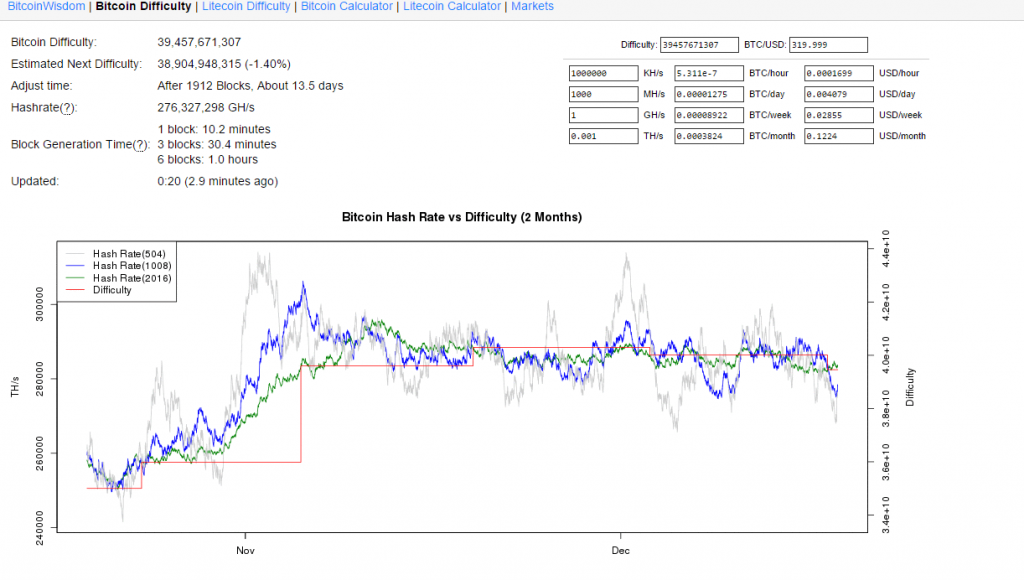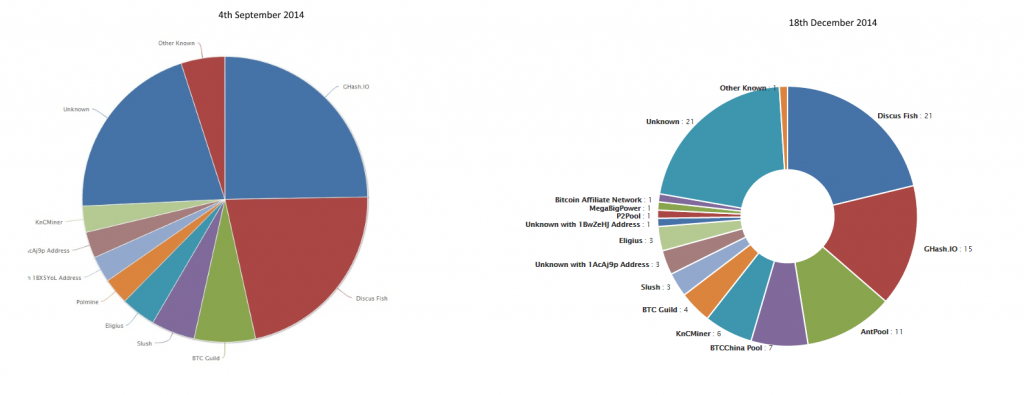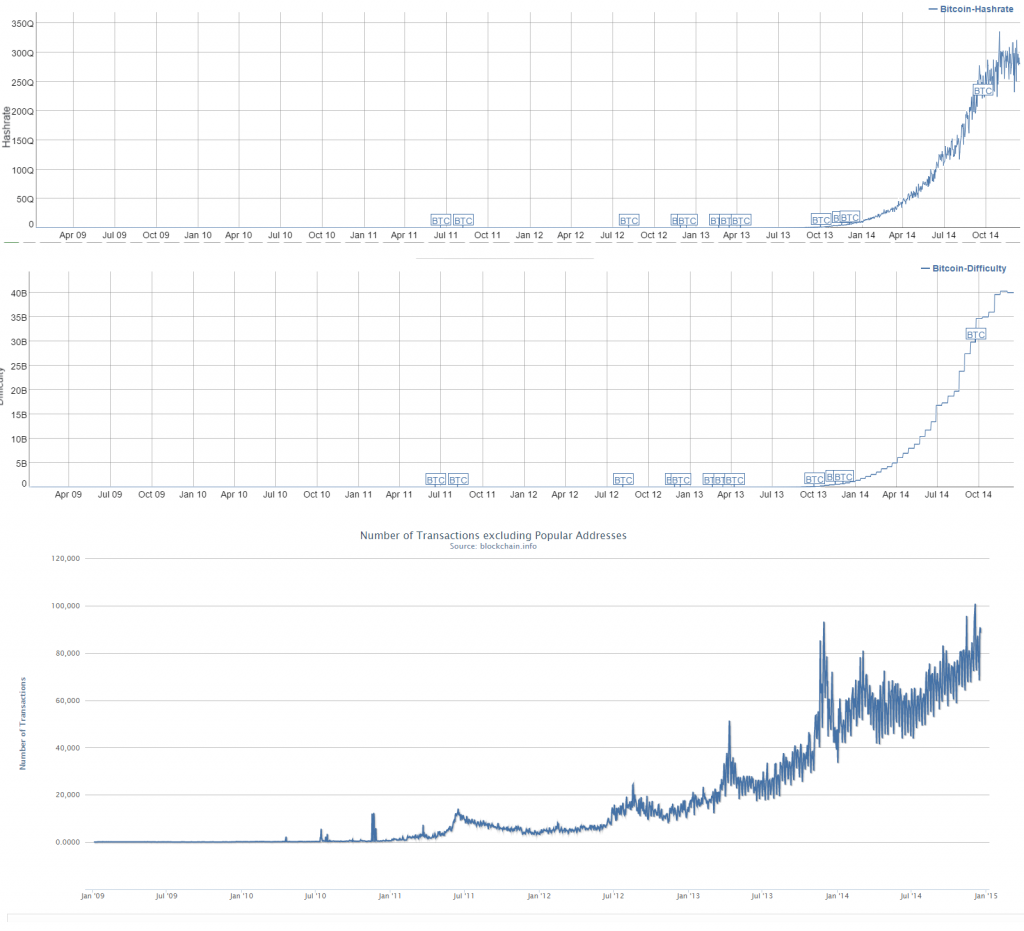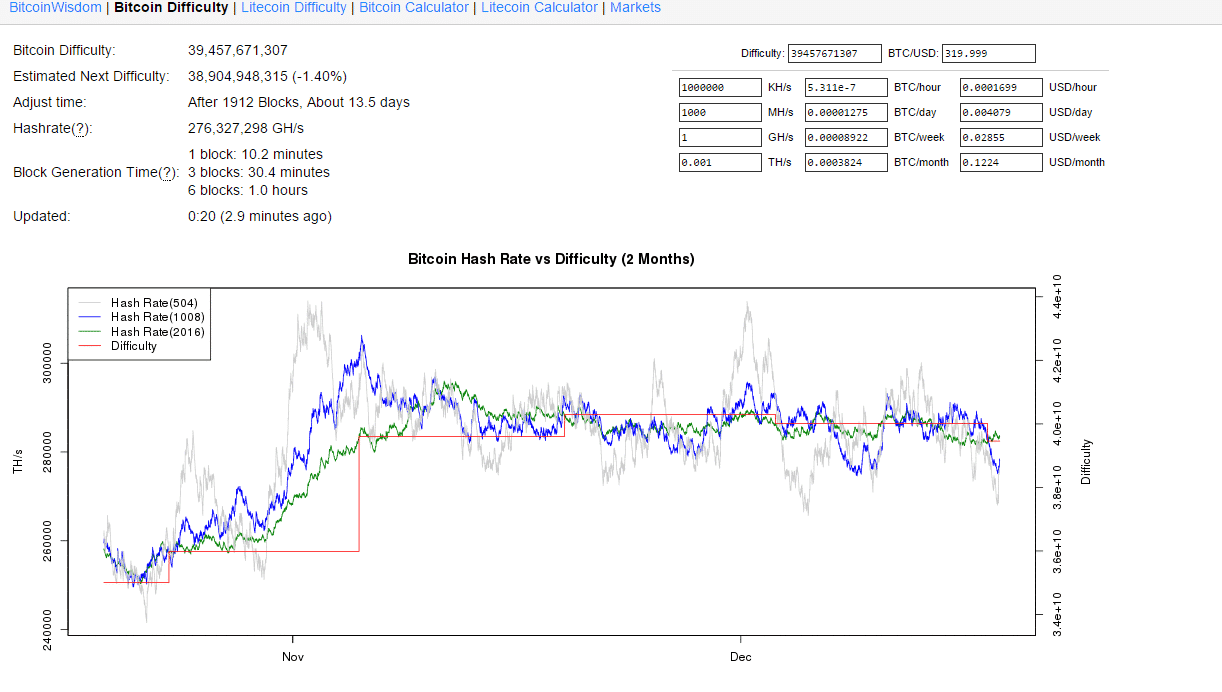
If you have been paying notice to the bitcoin difficulty recently, something of a watershed moment has occured. After a year of endlessly increasing difficulty as newer, more powerful and power efficient bitcoin mining hardware piled into the network. We thought we’d let our readers know about what this change in gear could mean, as we have recently been reviewing many of the mining pools to generate bitcoin with our four antminer s1’s, associated bits and bobs and our energy bill. We then recently reviewed the process of selling some of our bitcoin on a number of bitcoin exchanges. So as we’re using bitcoin in several ways, I wanted to sit down this evening to type up this article to take a step back, look some big picture stats to try and see where bitcoin is in it’s life cycle, ignoring the hysteria on exchange toll boxes and chat rooms.
There’s a couple of things at play here. The continued drop in price, from around the €300 mark a week ago, to €260 at time of writing will effect many mining operations who need to cash out to cover overheads. I’m someone who has been paid for work in bitcoin, and has been stuck for over a week getting nowhere verifying our bank account with coinbase, while the chunk of bitcoin we have ringfenced for their review has dropped 20% of it’s fiat value (ie I’m not impressed, get your act together lads), so it’s a big concern to me as a company. Some people who have been mining for some time now, either with new hardware, or with older machines past their breakeven point, are getting to the stage where running costs aren’t as profitable, if at all, than they used to be. I’m sure some people are pondering the option to either turn these off, or switch them over to an alt currency, such as GAWMiner’s recently launched Paycoin, which is compatible with much of the bitcoin mining hardware on the market today. The fact that one of the largest bitcoin hardware manufacturers is splitting into two directions, with bitcoin hardware sales and cloud mining on the one hand, and a new cryptocurrency on the other hand which it’s throwing it’s considerable hardware manufacturing weight behind, will cause shockwaves to go through the rest of the mining sector.

Lets look at the bitcoin difficulty changes since we started mining with our antminers at the start of September, as well as a screenshot of the market share the day we switched our antminers on, as we used this screenshot to determine our reviewing schedule.
We spent the first few weeks trying different pools, getting the hardware set up and running, and settled with Bitcoin Affiliate Network’s Mining Pool about six weeks ago around the 10th October. In this time, with two stock and two undervolted, hashing at an average of 650ghs pulling about 1100 watts for an average 8 hours a day (ie when it’s cheap electricity from the image plus proportional standing charge and 23% vat), our combined mining earnings to date are 0.27408331, and if we’d been running 24/7 it would be between two and three times this. We spent €200 on the four miners, about the same again for PSU’s, and then maybe another €50 on energy meters etc, so our modest investment is around €500.
Difficulty changes since we started mining
| Date | Difficulty | Change | Hash Rate |
|---|---|---|---|
| Dec 17 2014 | 39,457,671,307 | -1.37% | 282,449,013 GH/s |
| Dec 02 2014 | 40,007,470,271 | -0.73% | 286,384,627 GH/s |
| Nov 18 2014 | 40,300,030,328 | 1.76% | 288,478,854 GH/s |
| Nov 05 2014 | 39,603,666,252 | 10.05% | 283,494,086 GH/s |
| Oct 23 2014 | 35,985,640,265 | 2.81% | 257,595,247 GH/s |
| Oct 09 2014 | 35,002,482,026 | 0.98% | 250,557,526 GH/s |
| Sep 25 2014 | 34,661,425,924 | 16.20% | 248,116,151 GH/s |
| Sep 13 2014 | 29,829,733,124 | 8.75% | 213,529,547 GH/s |
| Aug 31 2014 | 27,428,630,902 | 15.03% | 196,341,788 GH/s |
Older, and increasingly smaller mining pools are feeling the heat from three sides, with discus fish maintaining market share (steady at about a fifth to a quarter of the daily blocks found), and a much diminished gHash which used to command well over 30% of the mining just a few short months ago, now has dropped to 16% in the week just gone. On the other side, you have a large increases in large private farms, and thirdly cloud mining operations increasingly backed by hardware manufacturers finding ever increasing proportions of blocks.

Stuck between these three macro factors, many of the smaller pools have felt the squeeze, dropping their market shares, which is being maintained mainly through loyal core communities, or are increasingly being being abandoned by miners, like ozcoin, a former heavyweight in the mining space. With hardware costs already incurred, ongoing energy bills, and decreasing rewards, combined with a depressed price, it is inevitable some will be forced out of bitcoin altogether, or choose to move pool, creating a large number of refugee miners. Do they pick a new pool? Do they back a particular altcoin? Do they mothball their equipment? Or do they sell their equipment on the second hand, which may cause further drops in the network hashrate.
As the bitcoin protocol self-corrects, people who do hold their own will see modest difficulty decrease in the short-term, marginally increasing their earnings, if they are mining somewhere that can find the blocks. Which is why it’s pretty important at this stage to consider what kind of pool you’re using. If you’re loyal, you’re not going to move anyway, but if you are wavering, there are a wide range of mining pools still out there to choose from. We’ve reviewed seven so far in our first series, with Slush’s old and new interface left to be reviewed before we choose the next four pools, and have had BitAffNet’s Mining Pool as our default pool for some time now, which has been steadily generating increments of bitcoin which we’ve been able to use to review some bitcoin shops for the site. For our (small-scale) mining efforts, it gave us the most predictable bitcoin earnings, with it’s PPS model, had an awesome real-time interface plus we like to back an underdog.
As I found at the Bitcoin Dublin event I attended on the 16th December, there really are three types of miners out there. The fully invested people don’t care what the bitcoin price or the costs generating them, they’ll continue to generate them regardless of the market conditions, managing their costs along the way with the dream of a million dollar per coin valuation. In the middle are people who have invested in hardware, but are concerned with ROI. Here, energy costs are a big factor, as well as hashes per kilowatt. If a batch of equipment becomes unprofitable, these may choose to take them offline or sell them to recoup some of their costs. These may alternatively move between pools in search of better earnings for their fixed amount of hardware, or move part or all of their mining power into altcoins.
For the third group (which I’d consider myself part of), there’s the hobbyists. With the decrease in difficulty, and the right pool, earnings can go up, and ROI calculations move closer, as opposed to further in time, which comes as a welcome relief. But the question is now as to whether the network will continue to decline, or stay stable around it’s current hash rate.
What’s going on with bitcoin right now isn’t any different to any game I’ve ever launched though, or a normal product life cycle.

The first period is when the product is being made, and the first two or three years of bitcoin’s existence could be said to be in this phase. A low amount of users, but working away nonetheless proving it works, holds out and can scale accordingly, with different updates to the core build along the way. There was the initial burst of users following these beta testers, followed by a second, third or forth wave last year jumping on board. Back then the issue was there wasn’t enough hardware to meet demand. Into the new year, as these hardware were delivered, the network began it’s marked increases in difficulty every fortnight, as power came on board. And with oversupply, depressed prices, and everything else going on, there is now a plateau in the growth of the network power. Looking at the graph above, you may think that bitcoin is entering into maturity. But keep in mind there’s a 40 year plan, and we’re only a few years in.
In reality though, I think the case is a little different. If you look at the technology adoption cycle side by side with the traditional product life cycle, you’ll see that there is a break along the way. I found in games that we’d always have our core players who were in from before launch and day one. We’d then have bursts of users come into the game, and a lot of these would drop off. As this went on, the product would improve, people who liked it would stick it out, and there would come the time when we found a sweet spot, where the initial spikes dropped, our numbers stabilised, and we could really build steady (not spectacular) cumulative growth.
If you look at the longer term in the games industry, this is clearly differentiated by new generations of consoles, which have life cycles up to a decade, where economies of scale (and corresponding profits) come by dropping the price of hardware after each consumer group has been maxed out at a particular price point. Console manufactures bar Nintendo take a hit on the cost of making this early hardware with associated capital costs, in the hope that they’ll make money back on disk and micropayment royalties further down the line, or through being able to reduce hardware costs for future batches. The games stay the same, it’s the hardware that improves, but still on a fixed framework.

So I would counter we’re just really entering the growth stage, and hitting a hiccup along the way. As consumer adoption increases by the day, and more and more people are exposed to the utility of bitcoin in their day to day lives, whether it’s sending money, buying things, trading, or accumulating bitcoins, this will continue as it’s beginning to hit a critical mass and slowly snowball. These consumers aren’t making coins, they’re buying them at the market rate, so difficulty isn’t a concern to them, and with fluctuation in price they’ll just have to spend them quicker, meaning that they may purchase the bitcoin more frequently, but in smaller amounts.
So with these two graphs above in mind, lets check three things, all time network difficulty, all time network hashrate and all time network transactions (excluding popular addresses) up to today, side by side.

When you look at it this way, you can clearly see it on a trendline, but I think the transaction volume is a good indicator of both network and consumer health. Despite the price drops and changes in the network hashing rate, this has continued unabated with a nice spike around bitcoin black friday. So I’m a firm believer that bitcoin is somewhere between the introduction and growth phase. It had stellar growth on the supply side, and it’s going to take a while for consumer demand to catch up, but there is a healthy, steady increase in users. The laws of economics will kick in, and where it will fall into equilibrium is unknown at this point.
The chasm in the graph from earlier can also be a period of time in stagnation. Often it takes time for those fans of a technology to get others using it, or to reduce churn but once the gears kick into motion, a sustained growth may be ahead. I’m not a market analyst or anything, but I know how consumers adopt technology from a decade in the games industry.
But when it comes to bitcoin, the 1983 Market Crash is probably a better harbringer of what’s to come. Here a load of people jumped on the bandwagon, made consoles and games of dubious quality (think hardware and altcoins), and retail buyers who had encouraged the fad, realised they were holding a load of stuff noone wanted, dumped their hardware and software stock in the bargain bin and wrote off the industry. There were lots of casulties along the way, but it fell from a value of over $3 billion, to a fraction of that. But with sales last year passing $93 billion, and counting despite the economic slowdown, the games industry is here to stay, just in a hyper-competitive state.
The industry focused moved elsewhere (to Sega, Nintendo and subsequentially Sony in Japan) for over a decade, with things stagnating, and the hardware waiting for new types of games to expand the market. and then games took off as technology improved, being a muse for whatever technology was there at the time. Each generation of games hardware used a different mix of hardware available to them at the time. Through multimedia (ie CD ROM), graphics cards, internet speeds, higher capacity cartridges, disks, dvd, blue ray and increasingly powerful hardware, each generation was defined by older incumbents bringing out new hardware, with new challengers trying to tap the market, often unsuccessfully .
Activision, the first third-party developer was founded because Atari programmers weren’t getting credit or reward for games that were making hundreds of millions of dollars (in the 1970’s), and forced Atari through a court decision to open up their consoles to third party software. When it went public in 1993, it was at this price
| Date | Open | High | Low | Close | Volume | |
|---|---|---|---|---|---|---|
| Dec 13, 1993 | 0.88 | 0.88 | 0.85 | 0.88 | 105,600 |
Fast forward twenty one years
|
The company survived everything along the way in one shape or form, and massively increased in value and volume. Can bitcoin do the same? In due course, I’m sure it will, which is why I’m happy to be an entrepreneur working in the ecosystem, and being able to work with exciting projects through the BitcoinMarketingTeam.com (sorry for the blatant plug, but a man’s gotta make a living!). But people in the bitcoin space shouldn’t be worried, there are very similar parallels and perils between their sector and games. Just while games have had 40 odd years to grow their market, iteratively getting better but dependent on the technology of the time, bitcoin is going through the same process – in a fraction of the time.
Is the concept of a distributed currency for the internet here to stay? Yes. Is bitcoin established? Yes? Will it maintain it’s position as the prime cryptocurrency? That’s for the market to decide. And the market isn’t the miners, or the traders, or the companies involved in the space. It’s normal, day to day people who can find a use for it, and adopt it as normal within a generation the same way that the internet, wifi, sms, paypal, ebay, and all the other concepts that the technological revolution. The financial industry is bloated, has banjaxed real people far away from Wall Street in very real ways, and ripe for change to the status quo.
Each day that passes, more people get accustomed to the concept of using a virtual currency, a lot of which are gamers in some shape or form, being the majority of a population in many developed countries. Unlike the generations before them who maybe dabbled in games and dropped out later, they never stopped being gamers. I’m only 32, but for my niece (who’s 14) as well as every kid who’s starting to get pocket money over the next few years, cash as a tangible thing will become irrelevant and inconvenient.
But with bitcoin easily integrated in EPOS systems. Remember that Microsoft, who just added support for bitcoin via bitpay, are one of the largest EPOS providers in the world. Many companies either have, or want to invest in new hardware or software for their shopping tills. Near field communications till points are getting out there, as banks issue cards that support them, meaning that people are going to be moving – in bulk – to contactless cards. Debit cards are for many people negating the need to get a credit card in the first place. Bitcoin just needs a killer app the same way that Nintendo has Mario, Sega has Sonic, Sony has Sack Boy, and Disney have Mickey Mouse.
What will it be? A brand? A product? A service? An app? Or something completely out of left field? That’s up to the rest of the bitcoin ecosystem to figure out, and people can get, buy and spend bitcoin relatively easily online now. Selling it into cash is still a big bottleneck, but getting it into the physical world and making it a real option to use and interact with for people day after day is the next challenge. And while all those changes happen, the chasm could go on for some time. Or just blitz through regardless.


